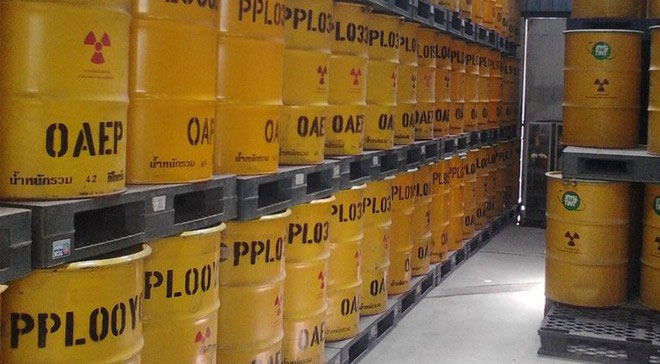The Nobel-winning physicist wants to treat radioactive waste by laser
Although only in theory, the proposal of scientist Gérard Mourou is considered to open a bright future for the treatment of radioactive waste which is extremely dangerous.
According to Extreme Tech, waste generated by nuclear energy is dangerous because it takes at least thousands of years or even millions of years to decompose. There is currently no way to shorten the decomposition time of these substances.
Therefore, Nobel Prize-winning physicist Gérard Mourou is calling attention to a very interesting solution. He believes it is possible to turn radioactive waste into a safer form. It sounds like an Alchemist, but this is his goal in laser research science.
Gérard Mourou won the 2018 Nobel Prize in Physics with Donna Strickland. They are honored for their invention of a technique called Chirped Pulse Amplification (CPA) at the Laser Energy Laboratory at the University of Rochester.

The barrels of radioactive waste after nuclear production are still in isolation bunkers all over the Earth.(Photo: Extremetech).
CPA produces very short laser pulses with extremely high intensity. Mourou and Strickland's goal is to develop a means of increasing the accuracy of laser cutting applications, which is useful in the medical and industrial sectors.
The initial research focused on laser processing and eye surgery applications, but scientists could also use it to observe processes that take place inside atoms.
This process happens at an unbelievably fast speed. According to Mourou, CPA can also be used to treat radioactive waste if it can increase its pulse rate to 'a little'.
Currently, radioactive waste is stored in isolated bunkers all over the world. But they are also a potential danger no matter where people store them.
The two most dangerous radioactive materials - Uranium 235 and Plutonium 239 - have a half-life of about 24,000 years. So these waste bins will take millions of years to decompose. According to Mourou, by laser, we can completely turn this waste into something that can be held in our hands.

Image illustrates close-up atomic level of nuclear energy.(Photo: Getty).
CPA can generate laser pulses down to attosecond (as) - a billionth of a billionth of a second. (The extremely short pulse generation - measured in time units - allows the concentration of extremely large laser energy in an extremely short time.)
In order to turn radioactive waste into safe things, Mourou said that the pulse rate must be increased by about 10,000 times. This is currently 'impossible'. With ultra-fast laser pulses, it is possible to bombard nuclear waste and dislodge protons from the nucleus. This procedure turns a dangerous substance like uranium 235 into something relatively harmless like lead.
However, other experts note that this is a physical study only at a theoretical level, because in laser technology development, 10,000 times it is still out of reach.
- Even robots died in the radioactive part of Fukushima
- Building a nuclear center in Hanoi to "utilize manpower"
- Leakage of radioactive waste in six US tanks
- Rare information about the first female scientist to win the Nobel Prize in Physics after 55 years
- Nobel Prize-winning chemist died at age 95
- Determine the date of the 2013 Nobel Prize
- The inventor of the laser died
- Marie Curie - From a hired girl to twice receiving a Nobel Prize
- Radioactive leaks in eastern Japan
- Hundreds of barrels of radioactive waste are found off the US coast
- Professor Anh calmly went to teach after winning the Nobel Prize in Physics
- The invention of laser won the Nobel Prize in Physics 2018
- Winning a Nobel Prize for eating lots of chocolate?
- Nobel Prize physicist once called for the abolition of Vietnam's embargo
 Is the magnetic North Pole shift dangerous to humanity?
Is the magnetic North Pole shift dangerous to humanity? Washington legalizes the recycling of human bodies into fertilizer
Washington legalizes the recycling of human bodies into fertilizer Lightning stone - the mysterious guest
Lightning stone - the mysterious guest Stunned by the mysterious sunset, strange appearance
Stunned by the mysterious sunset, strange appearance